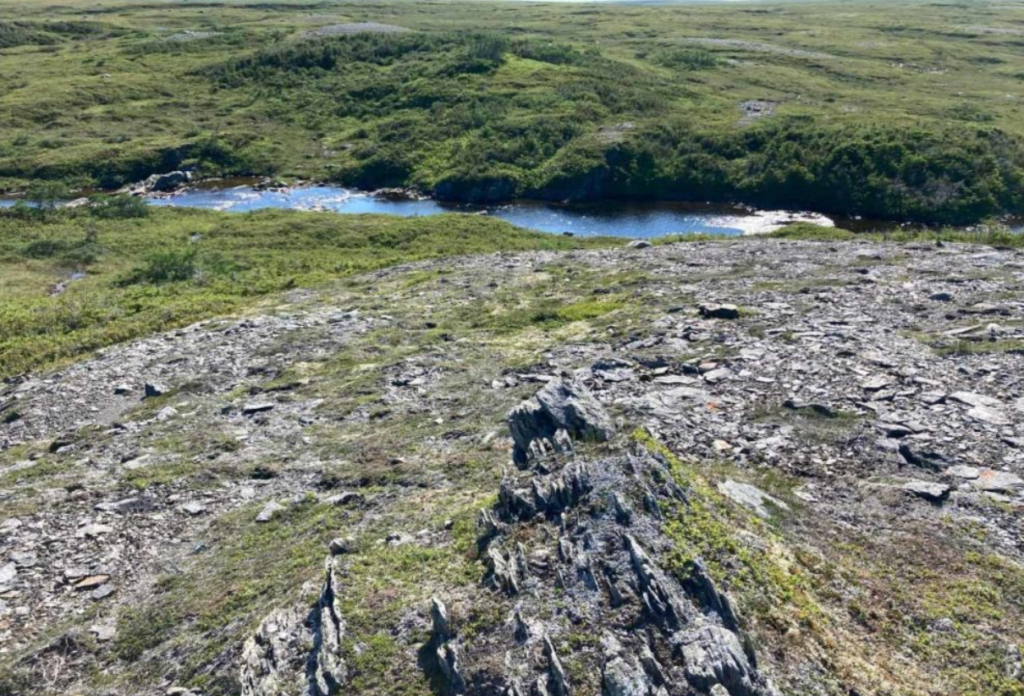Benton, Sokoman drill 0.95% Li2O over 8.4 metres at Golden Hope, Newfoundland

Benton Resources Inc. [BEX-TSXV; BNTRF-OTC] Sokoman Minerals Corp. [SIC-TSXV; SICNF-OTCQB] are releasing the final assay results from the 1,025-metre reconnaissance drilling program carried out this past winter and detailing recent trenching from the Kraken pegmatite field on the Golden Hope joint venture property in southwest Newfoundland.
Drill hole GH-22-01 returned 8.40 metres of 0.95% Li2O, including 4.50 metres of 1.52% Li2O, including 0.80 metres of 1.76% Li2O. GH-22-05 returned 16.20 metres of 0.43% Li2O, including 1.00 metre of 1.30% Li2O and 1.80 metres of 1.10% Li2O, 15.10 metres of 0.31% Li2O, including 1.75 metres of 0.94% Li2O. GH-22-06 returned 1.50 metres of 0.32% Li2O.
Benton’s President and CEO Stephen Stares, stated: “We are pleased to now have our camp, drill, and equipment on-site and operational. The stripping on the East dyke has shown excellent spodumene mineralization and has exposed geological contacts to help understand the orientation and behavior of the dykes in this area. With several prospective targets to test, we are excited to get our Phase 2 program underway on the East dyke in the coming days.”
Sokoman’s President and CEO, Tim Froude, commented: “We have learned a great deal from the recon drill program about the Discovery Dyke area and we will use that information, coupled with ongoing trenching data, to plan the Phase 2 program which will start imminently. We have already exposed a significant spodumene-bearing dyke in the eastern portion of the Kraken swarm that last year’s sampling returned an assay of 1.93% Li2O and this is where Phase 2 drilling will begin. We wish to emphasize that we have just scratched the surface with the exploration to date and that we have extensive work ahead of us to establish the limits of the dyke swarm.”
The winter drilling program and current trenching program have located a significant swarm of lithium-rich pegmatite dykes flanking the regional Bay d’Est Fault. Important structural information was obtained in the drilling showing the dykes, at least in the Discovery Dyke area, are relatively flat-lying, as opposed to vertical to subvertical, the original concept for the reconnaissance drill program. As a result, three of five holes (GH-22-02, -03, -04) did not intersect the target Discovery Dyke. Flat-lying dykes are potentially important as significant lithium (spodumene) mineralization at Piedmont Lithium’s Piedmont project in North Carolina is found in flat-lying dykes, which link subvertical dipping dykes.
Given the results of the recon drill program, the Alliance has mobilized an excavator to expose the dykes to ensure that all drill holes are oriented optimally to test the in situ spodumene-bearing dykes in the upcoming program. Recent trenching on a surface exposure that gave a grab sample assay of 1.93% Li2O which is located approximately 600 metres east of the Discovery Dyke, has exposed the thickest dykes encountered at Kraken (up to 22 m in apparent thickness). The Kraken Pegmatite Field has been sampled over a strike length of 2,200 m and has an apparent width of 1,200 m, with historical assessment reports indicating pegmatite dykes up to 6 km along trend.
